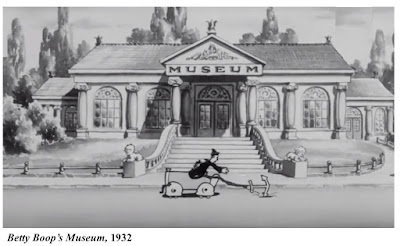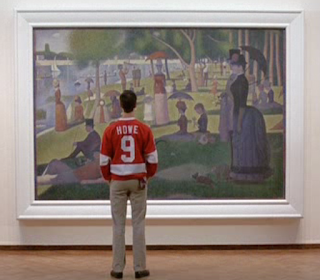Museums in Alfred Hitchcock Movies
Alfred Hitchcock made four movies with museum scenes between 1929 and 1966. For the famous director, there was clearly a value not only in the compelling visuals of a museum, but in the curious juxtaposition of high culture and criminal activity that a museum could provide
In Blackmail (1929), Hitchcock actually made the transition from silent to sound films right in the middle of making the picture, and he left the first several minutes quiet. The plot: Alice White (Anny Ondra) is dating a detective from Scotland Yard but gets frustrated with him on a date and leaves with another man, who attempts to rape her. She kills him and runs away, not knowing that a local thief, Tracy (Donald Calthrop) has seen her. When Tracy tries to blackmail her, Alice finally (!) tells her boyfriend what’s happening. The police chase Tracy to the British Museum. He races up the stairs and through the Egyptian galleries, at one point lowering himself on a chain in front of the giant carved head of Ramses II. He is chased into the famous reading room and up to the top of the dome, where he falls to his death through the skylight.
Hitchcock described the making of Blackmail to Peter Bogdonavich in 1963.[1] The actors, he said, weren’t actually filmed in the British Museum. “There was never enough light,” Hitchcock explained, “so we used what is known as the Schufftan process.”
You have a mirror at an angle of 45 degrees and in it you reflect a full picture of the British Museum. I had some pictures taken with half-hour exposures. I had nine photographs taken in various rooms in the museum and we made then into transparencies so that we could back-light them. That is more luminous than a flat photograph. It was like a big lantern slide, about 12 by 14. And then I scraped the silvering away in the mirror only in the portions where I wanted the man to be seen running, and those portions we built on the stage. For example, one room was the Egyptian room, there were glass cases in there. All we built were the door frames from one room to another. We even had a man looking into a case, and he wasn't looking into anything on the stage. I did nine shots like this, but there was barely any set that could be seen on the stage. … The chase on the roof was a miniature. We just built a skeleton ramp for him to run on.
For Strangers on a Train (1951), actors Farley Granger, Ruth Roman and Robert Walker were filmed in the National Gallery of Art in Washington, D.C. Granger’s and Roman’s characters are discussing how blissful the museum makes them feel when they are approached by Walker’s disturbed character Bruno, and the mood changes instantly. The art museum, with its sense of serenity and culture, was the perfect place to set the scene, which Hitchcock brilliantly exploits. That public confrontations should not take place in this setting is perfectly understood by the sane characters (and the audience).
When Hitchcock made Vertigo (1958), he used an actual gallery in the Palace of the Legion of Honor, a San Francisco art museum that was just one of the local landmarks used for the film. The museum added a painting to an existing exhibit—made for the movie and pertinent to the plot. James “Scottie” Ferguson (James Stewart) is a detective following the wife of an acquaintance. Kim Novak plays the twin roles of the wife, Madeleine, and Judy, who has been hired to impersonate Madeleine to convince Scottie that she is mentally unstable. At the museum, Judy/Madeleine stares at a painting of a supposed ancestor, Carlotta, who died by suicide many years earlier. Judy has a bouquet of flowers identical to the one held by the woman in the painting, and wears a similar hairstyle. Scottie has been told that Madeleine identifies with Carlotta in a dangerously compulsive way and this is the proof.
 |
| Jimmy Stuart observes Kim Novak observing a painting. |
In Torn Curtain (1966), Hitchcock again set an important sequence in several museum galleries, but this time there was no actual museum used. In the scenes where the American physicist Michael Armstrong (Paul Newman) is being chased through a museum in East Berlin, all of the complex backgrounds, with paintings, sculptures and architectural details, were matte paintings on glass by the artist Albert Whitlock. Newman was filmed in a mostly empty studio. The scene begins thirty-nine minutes into the movie: Newman's character looks up from a guidebook picture of the “Muzeen Zu Berlin,” to see the actual building (well, actually the painting of the building by Whitlock!). It’s too bad the movie is boring, because this scene is remarkable for Whitlock's artistic achievement.
 |
| Torn Curtain (1966) Museum exterior, painted by Albert Whitlock. Below are scenes in galleries, all painted by Whitlock. |
 |
 |
 |
| Museum Staircase in the Movie |
 |
| Filming the Staircase Scene in the Studio |
Note: As of 2 April 2020, all four of these movies are available to be rented on Amazon Prime Video for $2.98 each. Full versions for free can be found through a YouTube search.





Comments
Post a Comment